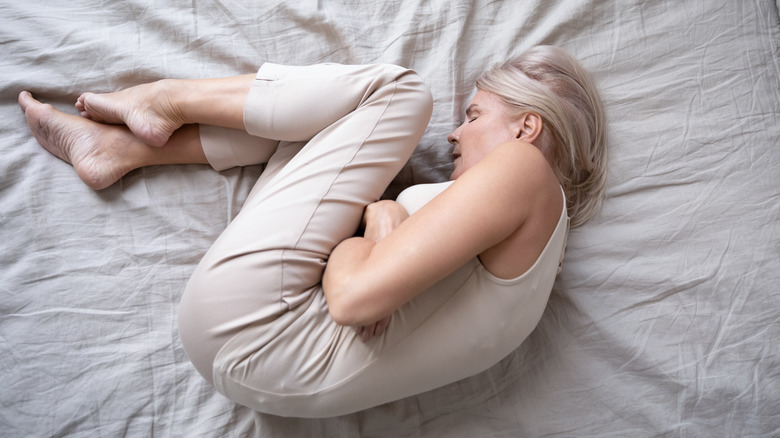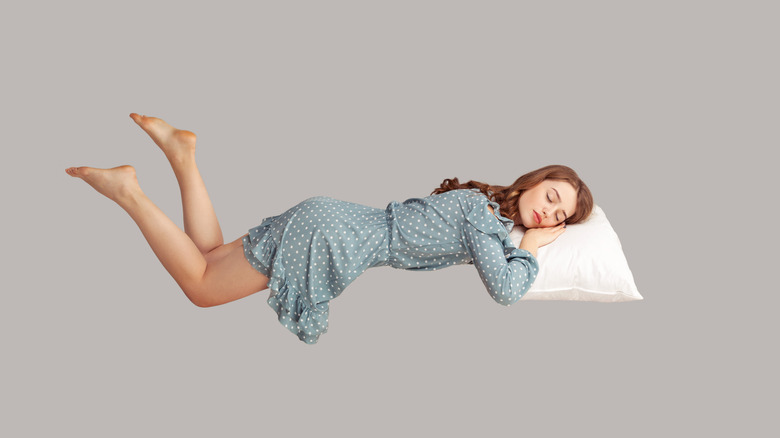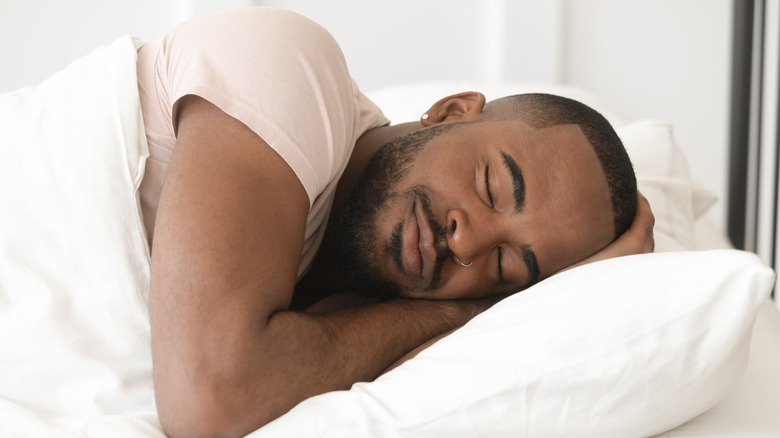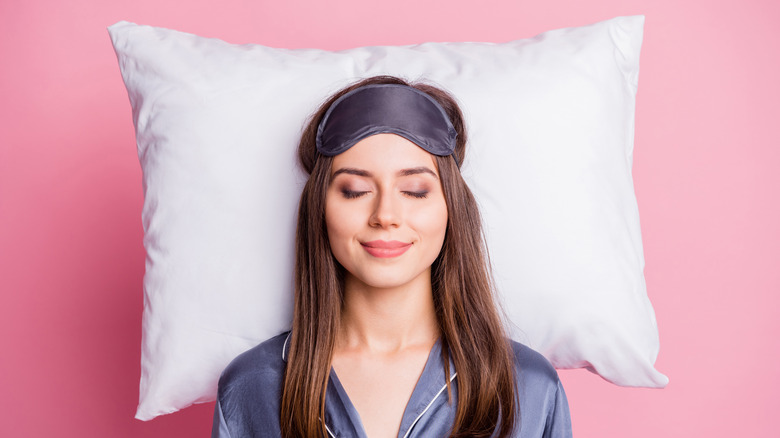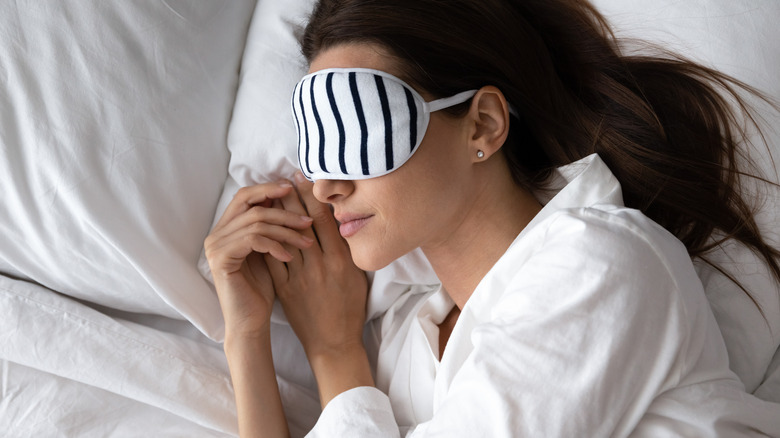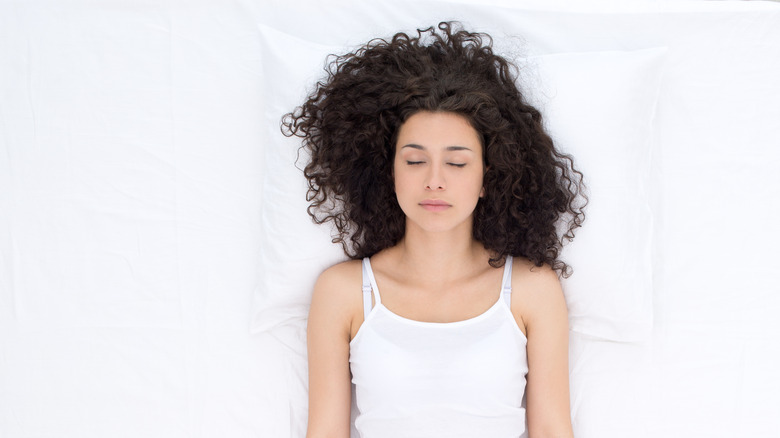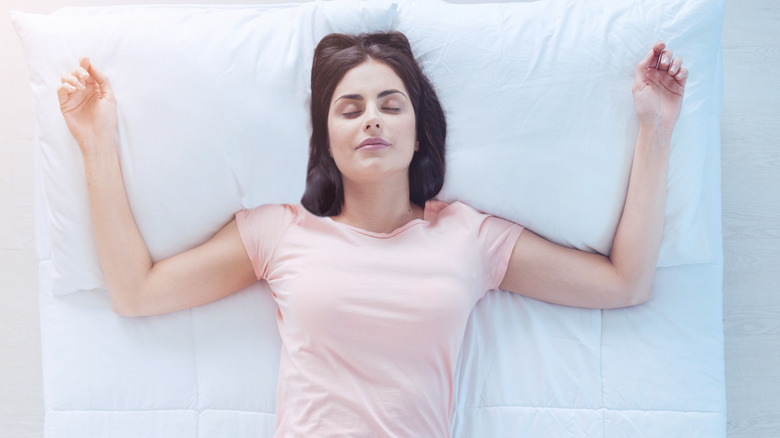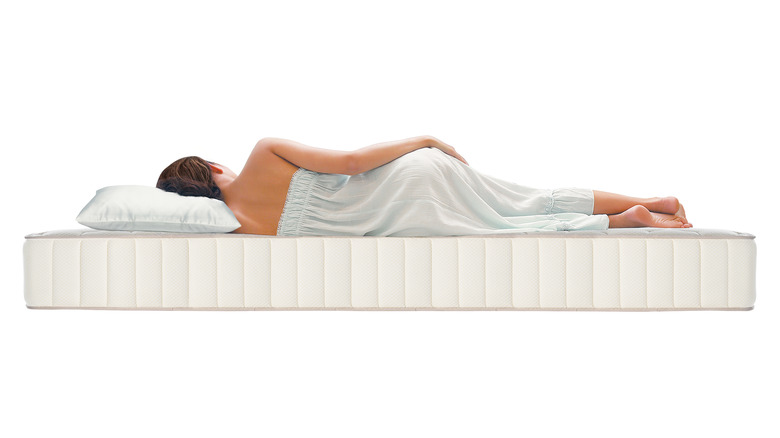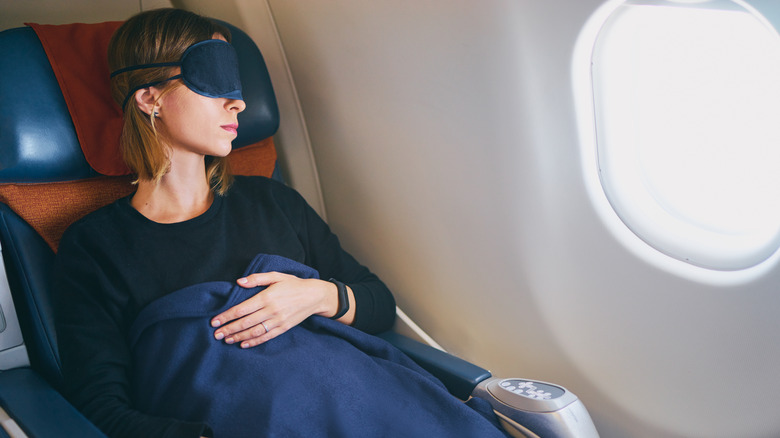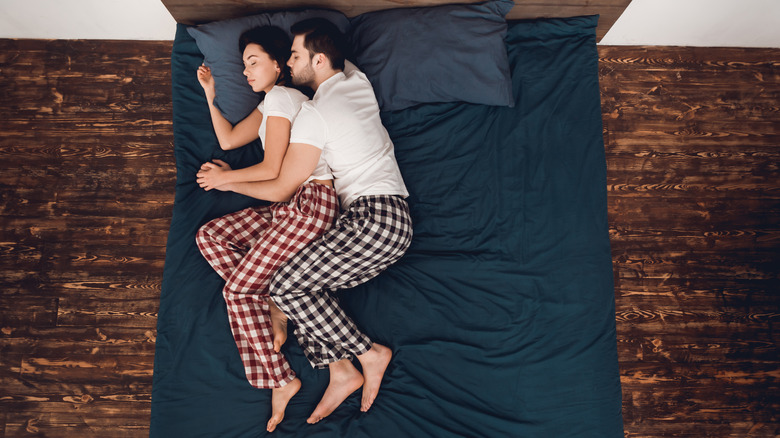Surprising Ways Your Sleep Position Can Impact Your Health
There's much to be said about the restorative powers of sleep. But when's the last time you really thought about your sleep position and how it impacts your health? If the answer is "never," it may be something to consider. After all, you spend a third of your life lying down (via Work). And research reveals that the way you position yourself in bed when you sleep has a far greater influence on your well-being than you might realize.
Everyone has their favorite sleeping position that they comfortably snuggle into, often without much forethought. Experts suggest that the best position is one where your muscles are as relaxed as possible and your body feels balanced and supported, allowing for muscle and central nervous system recovery while you sleep (via the BMJ Open). For instance, while it might be quite satisfying to fall asleep on your belly, research shows that it may not be doing your neck and back any favors. Read on to find out what your sleep posture means for your health and the various knock-on effects that each one can have.
Fetal position
Approximately 47% of Americans sleep in a curled-up fetal position, according to the Better Sleep Council. Head down, chin and knees tucked into the chest, arms pulled in close to the body — like babies in the womb. Women tend to be more drawn to this position than men (54% vs. 39%) while 37% of people describe it as the "best" posture to sleep in. There's something comforting about cozying up into a pretzel shape.
Yet, some people may find this position taxing to the spine, notes UC San Diego Health. It can also put some strain on the neck and back and hinder your breathing and circulation due to the pressure that's placed on your diaphragm. On the other hand, the fetal position is a form of side sleeping, which is generally protective against spinal symptoms and can help lower the likelihood of back pain upon waking, explained a study published in the BMJ Open. In order to maximize this position, try popping a pillow or rolled-up towel between your knees to keep your spine neutral and take some of the pressure off your neck, back, and hips.
Stomach
Roughly 7% of the population are tummy sleepers, estimates a study from Nature and Science of Sleep. This is sometimes called the "prone position" (via the BMJ Open). Another front-facing posture is referred to as the "freefall position," where you lie with your head turned sideways and arms placed under or wrapped around your pillow, detailed the Better Sleep Council. This is how 17% of people drift into slumber each night while 26% of Americans describe it as the "worst" position to sleep in.
One explanation for the unpopularity of the stomach-down posture is that it can be unsupportive for your spine, stretching it into an unnatural placement and increasing the load on your spinal tissues (via the BMJ Open). It can also throw your neck out of alignment and lead to all sorts of aches and pains. Being the foundation of your body, stress on the spine can then create stress on other regions of the body, which is why some people may notice tingling or numbness upon waking. Most experts recommend that the prone or freefall positions are largely avoided (via Work).
Interestingly, another possible motivation for letting go of stomach-sleeping is that it can lead to facial aging, highlight researchers (via the Aesthetic Surgery Journal). Lying facedown for prolonged periods of time can cause your skin to stretch and distort while it presses against your pillow, which can speed up the appearance of fine lines and wrinkles over time.
Left side
More than half of your time in bed is spent on the side (via Nature and Science of Sleep). In fact, side-lying with the arm stretched out over the head is one of the most common positions people like to take for a majority of the night, shows a 2017 study. And this increases with age as you lose spinal flexibility and find it trickier to breathe in other postures. One of the main reasons why sleeping on the side is favored — also known as the "lateral position" — is that it supports the spinal column by keeping it straight while reducing pressure by maintaining natural curves in the spine (via Work). Though, some researchers claim there's less contact surface for the body compared to lying on your back, which can make this position unstable.
Side-sleepers usually flip-flop throughout the night. But most experts recommend leaning to the left. This can help decrease your chances of heartburn and acid reflux, indicated a study from the Journal of Clinical Gastroenterology, which found that people who slept with their left side down were less likely to be exposed to esophageal acid. Left-side sleeping may also facilitate the natural circulation of blood throughout your body which returns to your heart. Christopher Winter, medical director of the Martha Jefferson Hospital Sleep Medicine Center, told CNN that when you lie on your right side, however, the weight of your body presses against the blood vessels that return to your heart.
Back
Back sleeping — also referred to as the "supine position" — is the second most popular posture after side sleeping, according to a study published in Nature and Science of Sleep. Research shows that women spend more time sleeping on their backs than men, possibly due to the fact that they have fewer posture changes throughout the night. Not everyone is able to get comfy lying horizontally on their backs with their face and torso facing the ceiling. But it has a pretty good reputation for its benefits.
If you're looking for an angle that's kind to your neck, head, and spine, then supine is the way to go, noted researchers (via Work). Arms can be stretched out overhead or by your side. This is optimal for spinal health because it evenly distributes your weight throughout your body and allows you to rest in a completely neutral position so that your muscles can fully relax and recuperate. It's particularly helpful for easing lower-back pain (via Johns Hopkins Medicine). Make sure your mattress and pillow properly support you, keeping your neck and back aligned — popping a pillow under your knees can also help maintain the natural curve of your lower back.
Right side
There are ample reasons why you might be better off sleeping on your side. The left side, in particular, is often touted for its health benefits. But some researchers also advocate for right-side sleeping, pointing out that the weight of your liver can put pressure on your stomach and lungs when you sleep on the left (via Work). In truth, research suggests that there are no real differences between sleeping on your left side versus the right.
Side sleeping, on either side, is generally preferred by people with heart failure, as it lessens the impact of an enlarged heart beating against the chest wall (via Nature and Science of Sleep). Scientists have also discovered that sleeping sideways may lower your chances of encountering cognitive problems later on in life. A study published in The Journal of Neuroscience found that sleeping on the side, as opposed to your back or stomach, may help the glymphatic system — your brain's waste clearance system — function more efficiently and flush out toxins from your brain via tiny lymphatic vessels called glymphatics. The buildup of these waste chemicals, specifically amyloid beta (Aβ) has been identified as a contributing factor to the development of neurological conditions like Alzheimer's disease. The study adds to previous findings that have highlighted the importance of sleep quality when it comes to preserving your cognitive capacities.
Sleepy soldier
The sleepy soldier is another way to get some shuteye on your back. It involves lying horizontally with your arms by your sides, close to your body. This position is adopted by around 11% of people, reports a survey conducted by the Better Sleep Council. And folks who sleep this way tend not to shuffle around as much throughout the night as those who take on one of the other sleep positions.
The soldier has a number of advantages, noted the Sleep Foundation. It offers natural spinal support to your body which makes it one of the best positions for preventing neck and back pain. It's easy to see why so many people find this posture conducive to a good night's sleep. On the downside, back sleeping, in general, might not be ideal for people with obstructive sleep apnea — a sleep disorder where breathing is hindered and compromised (via Sleep Medicine Reviews). The supine position tends to exacerbate the condition, causing the throat muscles and tissue to excessively relax and the airways to become blocked. Sleeping on the back can also worsen acid reflux symptoms in some people, indicates research from The American Journal of Gastroenterology.
Starfish
Another variation of the back position, "the starfish" mimics the sea creature that the title alludes to (via BMC Musculoskeletal Disorders). Sleeping this way means lying on your back with your limbs splayed out and arms stretched up near your head rather than down by your torso. Roughly 5% of sleepers opt for this less conventional posture, and it's often associated with a lower-quality, less restorative night's sleep, Chris Idzikowski, a professor and the director of the Sleep Assessment and Advisory Service, told BBC News.
The starfish is one of the more favorable postures to adopt if you're worried about wrinkles since you're not squishing your face on your pillow as you would if you were lying on your tummy (via the Aesthetic Surgery Journal). Your neck and spine may just thank you, too. Sleeping on your back, particularly with a supportive pillow, is generally protective against back pain because it enables you to keep your spine aligned, explained the Sleep Foundation. On the other hand, it can actually make neck and back pain worse for some people. There's a fair amount of pressure put on the shoulders with the arms flung up overhead, so if you find yourself grappling with some shoulder pain over time, you may want to occasionally shuffle into the "soldier" position. And again, a proper pillow can help make all the difference.
Like a log
Sleeping like a log may sound peaceful and comforting — and for the 15% of people who choose to doze off this way, it probably is (via BBC News). But resting on your side, whether you take the shape of a starfish or hunk of wood, can make existing shoulder pain worse if it means you're placing excessive pressure on one side (via Medical Hypotheses). To reduce the risk of pain, it could help to alternate between different sides. A good-quality pillow that keeps your head and neck aligned with your shoulders is a must — as is a supportive mattress, noted Johns Hopkins Medicine.
Sleepers who adopt this posture keep their arms extended by their side and their legs stacked straight, a bit like a log of wood. While the position can appear stiff, people who prefer this way of resting are usually easygoing, sociable, and trusting of strangers, according to Chris Idzikowski (via BBC News).
Researchers consistently recommend side-sleeping for chronic snorers since this angle is said to lessen the compression of the airways. A study published in the journal Sleep and Breathing revealed that when sleepers took the side position, the duration and intensity of snoring were lower. Snoring occurs when the upper airway of the throat and nasal passage vibrate as air flows in and out while breathing during sleep (via Sleep Foundation).
Yearner
Around 13% of people in the U.S. drift off in the "yearner" position, according to the Better Sleep Council. If your chosen sleep posture involves lying on your side with your arms stretched out in front of you — sort of like you're reaching out for something (hence, the name) — it's said that you may have "an open nature" but you can also be suspicious and cynical, and slow at making up your mind, according to Chris Idzikowski, per BBC News.
Akin to other side postures, the yearner is recommended for people struggling with obstructive sleep apnea, which is caused by "repetitive bouts of upper airway obstruction during sleep as a result of the narrowing of respiratory passages" (via The Ochsner Journal). Sleeping on the side can provide some relief to the collapsed airways of a blocked nose. A study from the Journal of Clinical Sleep Medicine showed that 50% of people with mild obstructive sleep apnea and 19% with moderate obstructive sleep apnea saw their symptoms reduce by 50% when they slept on their side. Another study found that patients' breathing difficulties diminished in both severity and frequency when they took a sideway position while snoozing (via European Journal of Heart Failure).
Upright
The upright position might not look or sound particularly cozy. But it does have its benefits, especially if you're frequently snoring and would like to stop. Sleeping at a slight incline can relieve pressure within the nasal cavities and help prevent the airways from collapsing, noted Verywell Health. Sleeping on your back with your head elevated is another way to reduce esophageal acid exposure and alleviate some of the symptoms of gastroesophageal reflux, reports a study from the Journal of Gastroenterology and Hepatology.
Verywell Health recommends raising your head above your body by about 20-30 degrees, but you can opt for an angle that feels most comfortable to you. Dozing off in a recliner or using a sleeping wedge pillow is a great way to help you keep your head slightly elevated throughout the night. While this position is generally considered to be safe, some individuals have a heightened risk of a blood clot if they're upright for an extended period of time, warned the Sleep Foundation.
Most people find it difficult to sleep soundly in the upright position. While sleeping, you cycle through four phases, explained the Sleep Foundation. During the final stage, you enter rapid eye movement (REM) sleep, where the body experiences temporary muscle paralysis due to loss of muscle tone, causing the arms and legs to become limp. This can make it tricky — not to mention uncomfortable — to keep your head up and maintain a straight back and neck.
Spooning
Sure, it feels good — but there are actual physical and emotional pros to spooning, noted researchers (via Psychosomatic Medicine). Lying closely side-by-side with a bed partner generates the release of oxytocin, also known as the body's natural "love hormone" and a chemical that has a calming influence. The study, which looked at 38 couples between the ages of 20 and 49 who were residing together, uncovered a strong link between feeling supported by one's partner and greater oxytocin levels. This was the same for both men and women. Research has shown that not only can higher levels of oxytocin that are induced from frequent hugs make people feel more secure and comforted, but it can also help regulate blood pressure and heart rate (via Biological Psychology).
In case you've not yet reveled in the joys of spooning, this position alludes to a type of cuddle in bed where two people face the same direction. From a bird's-eye view, it can look a bit like two spoons stacked next to each other in a cutlery drawer, romantic and snug. And then there's the added benefit of resting on your side. Sleeping in a non-supine position has generally been found to alleviate nasal congestion, compared to lying on your back — which often has the opposite effect — exacerbating nasal stuffiness and allergies, which tend to set off heavy snoring (via the International Forum of Allergy & Rhinology).
Sleeping while pregnant
It can be hard to get comfortable doing just about anything when you're pregnant, including sleeping. But there are a few positions that can help. Doctors often recommended pregnant women to rest on their left side because it takes the pressure off the large vein that transports blood from the lower part of the body to your heart (via MedlinePlus). The heart can then pump blood more efficiently among the organs and to the placenta. Switching sides throughout the night can also give the baby more room in the womb and help the mom-to-be avoid cramping, which can occur from being in the same spot all night.
Keeping the knees slightly bent by placing a pillow between your legs can take off stress from your back, advised the Sleep Foundation. Other strategies include placing a rolled-up towel under the abdomen or lying on the side while propped up by pillows, particularly if you're having respiratory problems and struggling to catch your breath. You may want to avoid the supine position while pregnant — this position can put a lot of pressure on your back and cardiac system while sleeping, causing your blood pressure to plummet and slowing down the circulation of blood to your baby. Equally, sleeping on your bulging belly won't be the most comfortable choice — though, a donut-shaped pillow could help do the trick.


